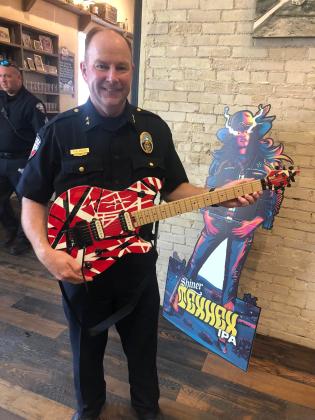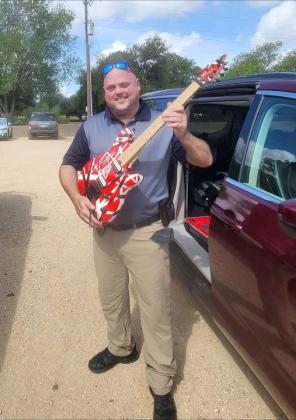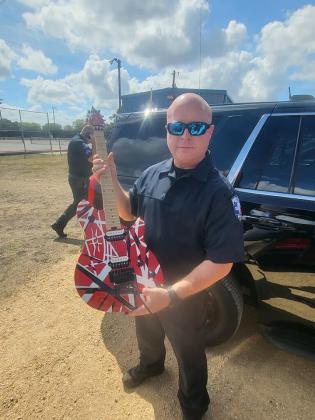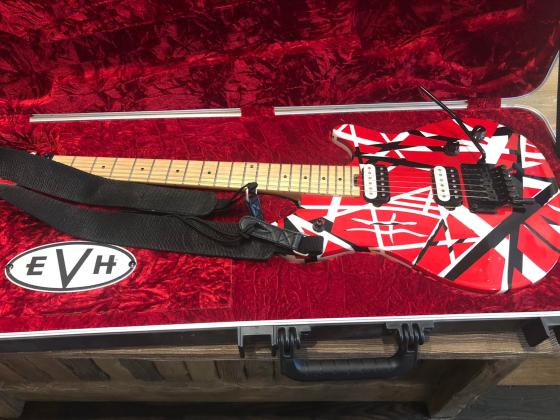Is that...? Naw, it couldn't be...But it sure looks like...
If you're thinking that couldn't possibly be the late Eddie Van Halen's vividly painted "Frankenstrat" guitar you see there, you might just want to think again.
While perhaps not the original Frankenstrat that the legendary rocker literally built from ground up using nothing but scrapped guitar parts (hence the "Franken" part of its title, and the "strat," coming from the only part really worth anything on that entire original version: A tremelo bar from a 1958 Fender Stratocaster), it was most definitely one of Van Halen's guitars, given by his family's estate on behalf of the nation's first responders in appreciation of the Spoetzl brewery's generosity and interest in another of the family's projects, according to what Shiner Police Chief Kevin Kelso told the newspaper last week.
Van Halen, for those not familiar, is regarded as one of the greatest guitar players in rock history, and was well known for popularizing the tapping guitar solo technique, allowing rapid arpeggios to be played with two hands on the fretboard.
Born in Amsterdam in 1955, they later moved to the United States and settled in Pasadena, Calif., where the young Eddie and his brother Alex, instantly took to music (though Eddie never did learn to read it). Their first band, The Broken Combs, performed at lunchtime at Hamilton Elementary School in Pasadena when he was just a fourth grader.
Heavily influenced by the British invasion, and guitarists like Eric Clapton and Jimmy Page, he soon found himself among their peerage, though he fought many a demon with drug and alcohol addications throughout his life. He passed away Oct. 6, 2020, with his family at his side, from complications of throat and lung cancer.
He was just 65.
Known to an inveterate tinkerer, his Wikipedia article states, Van Halen played many custom-built and heavily modified guitars, especially early in his career.
Upon embarking on his professional music career, he purchased a Gibson Les Paul, for which he replaced the original P90 pickup on the bridge with a humbucker in order to sound like Eric Clapton. He later bought and briefly used a Gibson ES-335, also because of its association with Clapton, though he damaged the body while modifying it and it later became canibalized for parts on numerous other home-build guitar projects.
He also owned an Ibanez Destroyer that was used extensively on the debut Van Halen album. Originally used in its natural wood finish, he later painted it white and made several modifications to the electronics.
After recording the album, he used a chainsaw to drastically modify the body shape, cutting a deep V into the bottom of the guitar, and painting it in a similar way to his later, more famous, Frankenstrat.
Inset into the V, he hand carved teeth and set two eyehooks and chains; the new distinctive shape led to it being nicknamed "The Shark". He only played it for a short time in this state, however, as the modifications changed the tone of the guitar in an unsatisfactory way; he did retain the guitar for the rest of his life, remaining in his collection until his death. The final state of the Shark can be seen on the cover of Women and Children First, where he posed with the guitar.
He is most associated with the Frankenstrat, a custom guitar he built from parts. The maple neck cost $80, while the ash body was bought for $50 as the wood had a knot in it. The 1958 Fender Stratocaster tremelo bar and was later replaced with a Floyd Rose arm. He frequently replaced the neck on the guitar, going through a number of different ones through the years, and the pickup configuration was also frequently changed. In its most commonly used configuration, the guitar had a single functional pickup, a Gibson PAF bridge pickup from his ES-335, which he enclosed with paraffin wax to prevent feedback.
The middle pickup was removed and in its place he had stuffed a non-functional selector switch and random wires, while the neck pickup slot was replaced with a red single-coil pickup, that was also non-functional. The original selector switches and tone knobs were removed, and the volume knob was replaced with a knob labeled "TONE". The Frankenstrat, as shown on the cover of Van Halen I, was originally painted black, but was recoated with Schwinn red bicycle paint in 1979.
Before and during the recording of Van Halen II, he built a second "partscaster" guitar painted in a distinctive black-and-yellow striped paint job that earned it the moniker "The Bumblebee Guitar". That guitar was later donated to Rita Haney, the longtime partner of Dimebag Darrell Abbott, shortly after his death; it was placed in his casket and buried along with him.
Eddie Van Halen used a mini-Les Paul guitar for "Little Guitars" (Diver Down). This is the only Van Halen recording that the guitar was used for. The mini-Les Paul was made by Nashville luthier David Petschulat and was pitched and sold to him during a tour stop in Nashville, Tenn. He later purchased a second mini-LP guitar, built to slightly different specs, the first being a honey-sunburst with mini-humbuckers, and the second being dark wine-red with a thicker body and full-size humbuckers.
In 1982, Van Halen made his first guitar endorsement by launching the 5150 Baretta model with Kramer. This partnership lasted a decade. In the mid 1980s, he purchased a Steinberger GL2T guitar. Its distinctive switch-operated vibrato system can be heard on the 5150 album. In 1991, Van Halen began working with Ernie Ball / Music Man, developing the Music Man EVH model guitar — a partnership that lasted until 1995. In 1996, Van Halen teamed up with Peavey, where they developed the Peavey EVH Wolfgang; this relationship lasted until 2004, when Van Halen joined forces with Fender, initially releasing the Edward-endorsed Art Series guitars under Fender's Charvel brand and later developing the EVH brand.
In 2006, Fender created the "Frank 2", a near-perfect production replica of the original Frankenstrat; Van Halen later claimed that when presented the two guitars in a blind comparison, he had some trouble picking out the original home-made guitar from Fender's production replica.
Anyone who ever saw any MTV music videos in the late 1980s knows that Van Halen made this particular guitar famous in the video done their song “Jump!”
So how did it wind up in Shiner?
Chief Kelso said that one of the gentlemen who arrived from the TxDOT Yoakum Office at last week’s event in Green Dickson Park to assist with the PD’s local child car seat clinic had brought out the treasured instrument for local officers to admire. iT seems the fellow at TxDOT flies with a vintage air force club, and in helping with another Van Halen estate charity the brewery helped deck out a vintage fighter jet in its trademark Shiner Bock gold and red.
The Van Halen family apparently sent the guitar along for them to add to their collection of memoroabilia as a show of their appreciation.
“It was quite the honor just getting to hold it,” Chief Kelso later shared. Others participating in the car seat clinic included the Texas Department of Public Safety, Texas AgriLife Extension Service, and the Kaspar Foundation.






